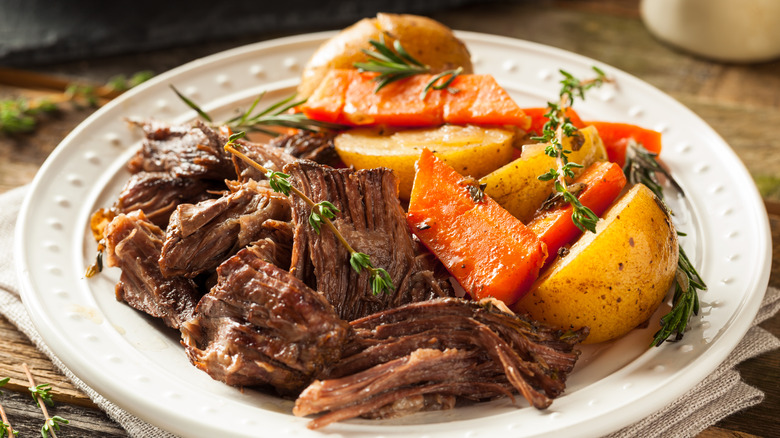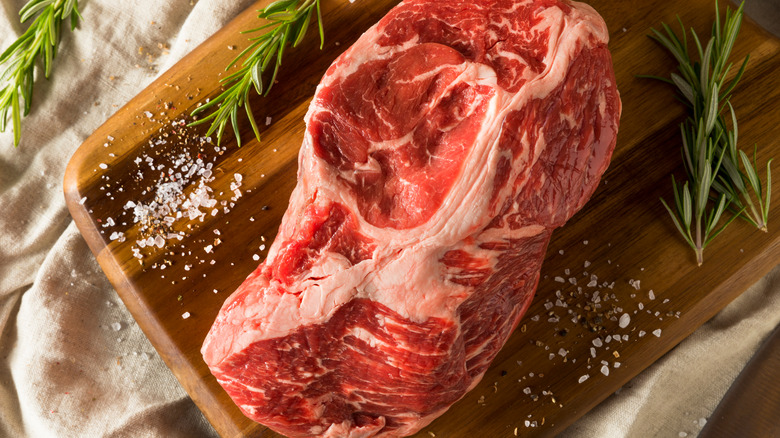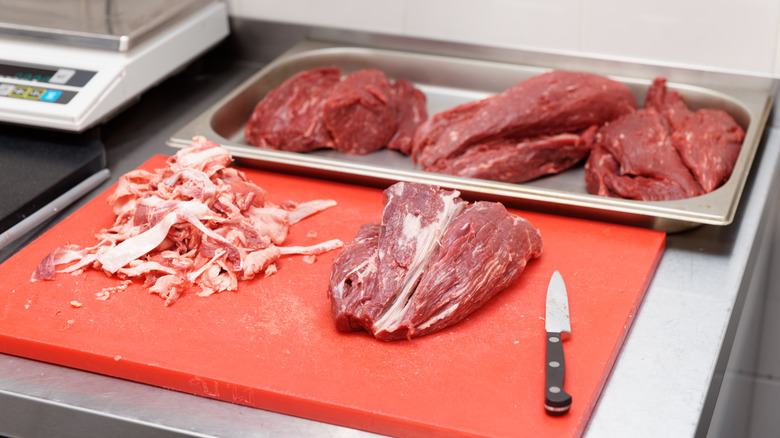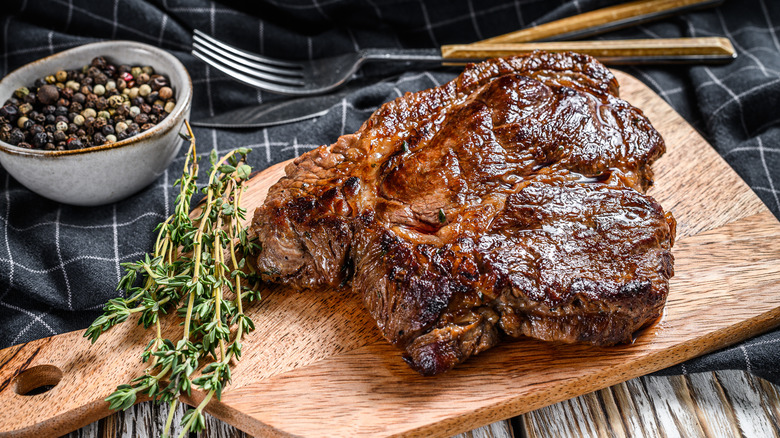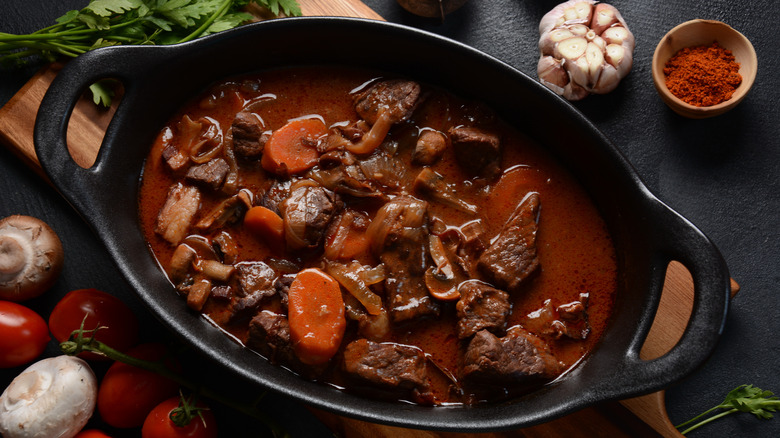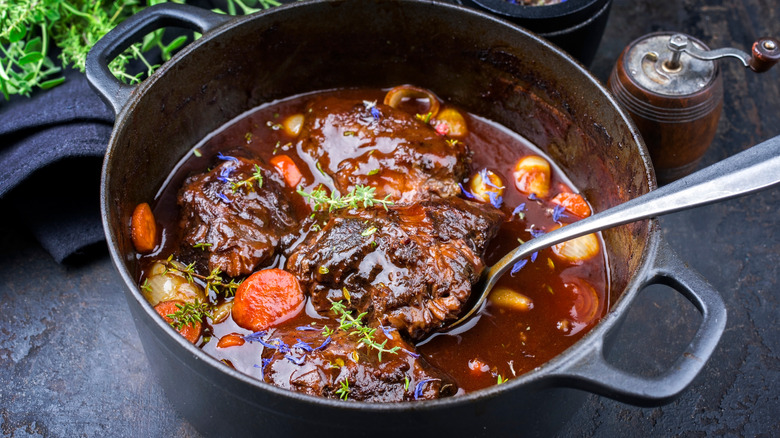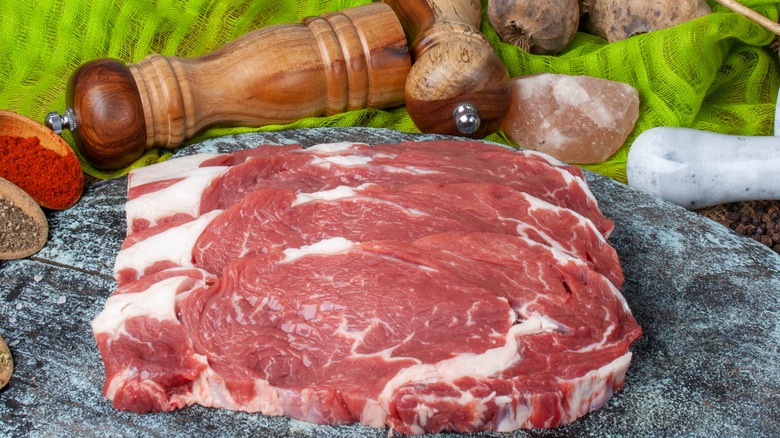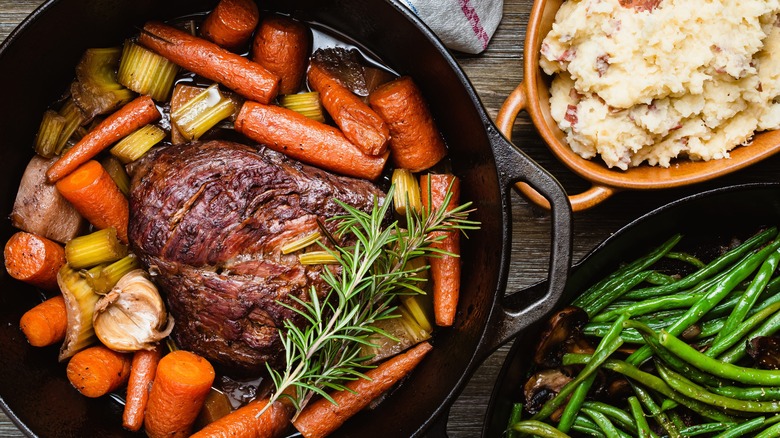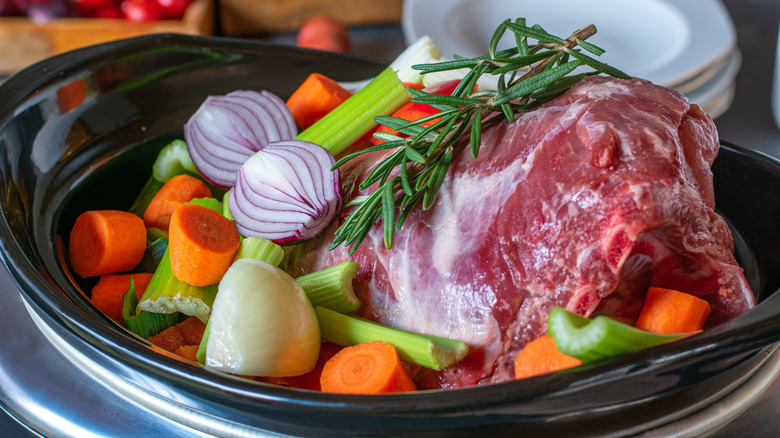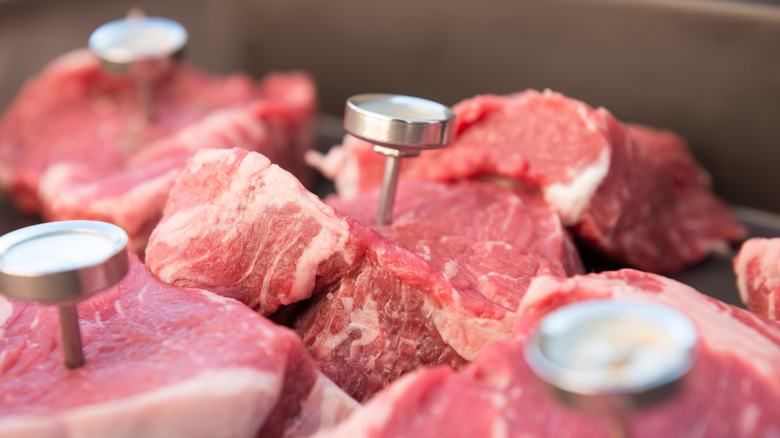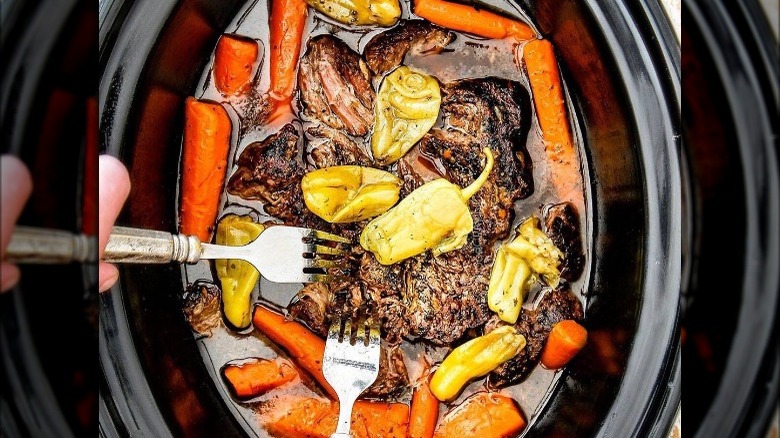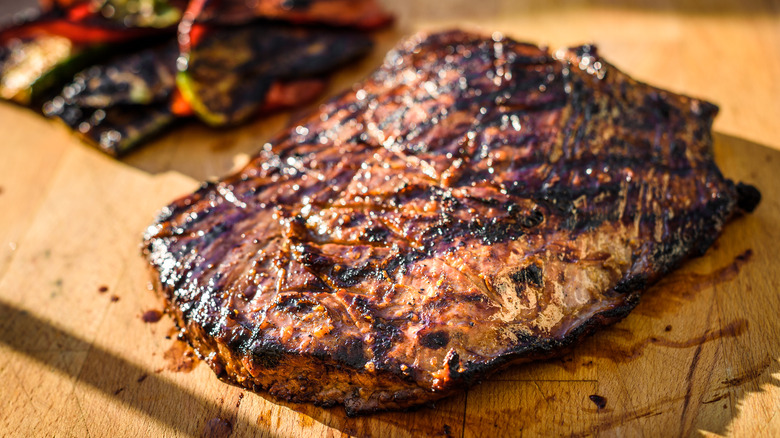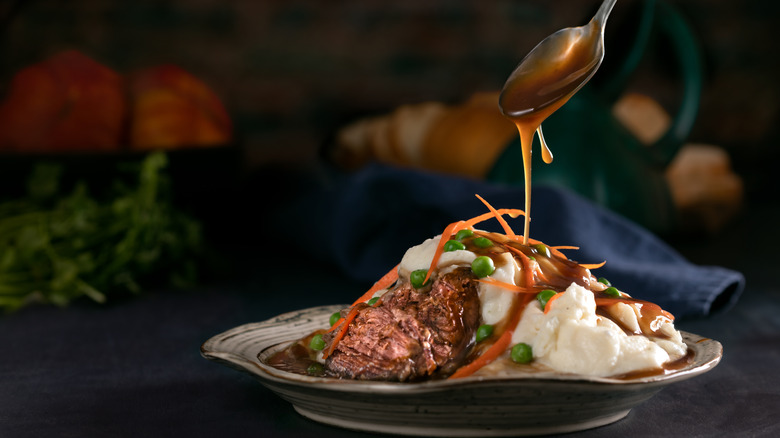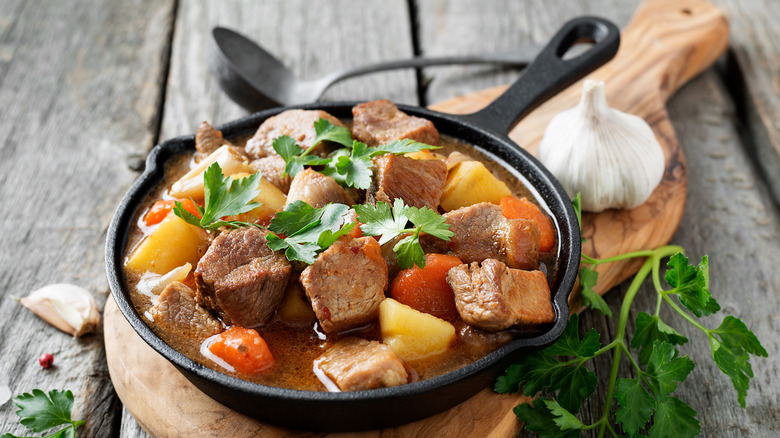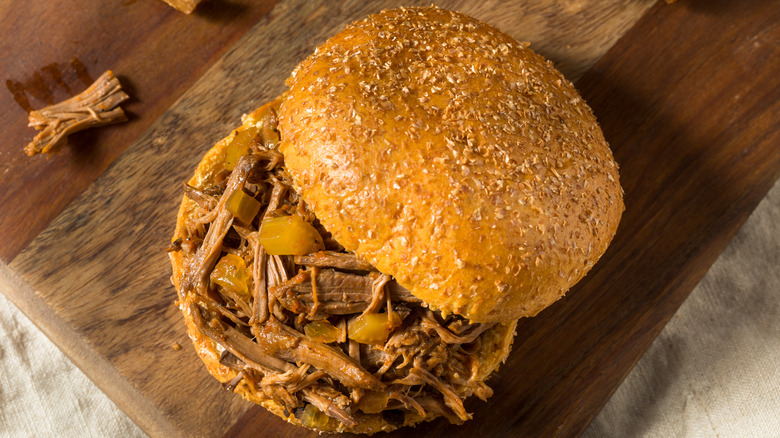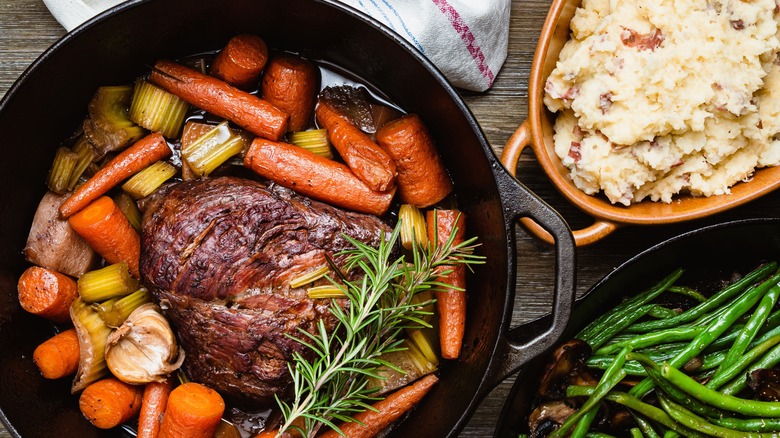Mistakes Everyone Makes With Pot Roast
Middle-class America grew up on pot roast. If you're one of those children for whom pot roast was on the regular, rotating menu of dishes that mom (or dad) made for the family, then maybe you cynically assumed pot roast was easy to make. You might have thought to yourself, "There's dad (or mom), throwing a hunk of meat in the slow cooker with some potatoes and carrots because they don't really feel like cooking tonight." That doesn't mean that you didn't love your parent's pot roast. Somehow, this large wad of meat, typically beef, was uniformly juicy, tender, and practically melted in your mouth.
Now that you're all grown up and have tried to relive fond childhood memories by making this meal yourself, you probably learned the hard way that it takes more than a functioning slow cooker to make a tender, flavorful pot roast. There are a few common mistakes that you're probably making, so we're here to help you recover some small part of the magic of your childhood. By the end of this article, you'll be well on your way to a mouthwatering pot roast.
Don't choose a pricey cut of beef
First, choose the right cut of beef – which is really key for whatever beef dinner recipe you're making. You need a part of the cow that got some exercise — something tough, lean, and laced with a lot of tendons or ligaments. This connective tissue is not good for a fancy steak, but when cooked properly, pot-roast style, that sinewy stuff breaks down to add tenderness and richness to your roast (via The Kitchn). Recommended cuts are the chuck (shoulder), brisket (chest), and round (hind legs).
Before putting your roast in a slow cooker or a sealed pot in the oven, brown all sides of the meat (via The Kitchn). This extra step will boost the flavor of your pot roast because it creates what cooks like to call "browned bits" that stick to the bottom of the pan. Deglaze those bits with liquid, but don't use boring water or beef broth. Add another flavor dimension with red wine, with maybe some tomato paste. Keep the liquid in the pot during the slow cook.
Forgetting to trim some of the fat
A big draw to making stews and braises is that they take so long to cook that the meat will fall off the bone and separate from the fat. A little fat can add a lot of flavor to your pot roast, but it can also turn your roast into a big greasy mess if you don't forget to trim anything too egregious.
Some roasts have large fat caps that are easy to chop off that should get the job done. A lot of the smaller pieces of fat will be rendered out while it's cooking and add flavor, so there's no need to go overboard with a butcher knife (via Johnson City Press).
"I would recommend that you trim off the fat cap or any big veins of fat that you don't want to bite into; otherwise, you'll end up degreasing your stew until you're sick of it," u/albino-rhino wrote on Reddit. "Anything small enough and part of the meat, leave alone."
Not browning the meat first
Pot roast can be an appealing weeknight meal because it's relatively easy. That's why everyone loves a good crock pot meal: It requires minimal effort and usually creates the least amount of dirty dishes as possible. While it sounds too easy to be true, there is one extra step to elevating your pot roast to the next level: Browning the meat before letting it simmer (via Rachel Ray).
Searing any piece of meat creates a Maillard reaction, which causes the sugars and proteins inside a piece of meat are broken down due to heat. It adds a caramelized effect to the exterior of the meat, which ultimately benefits the texture of the resulting pot roast.
Searing meat is essential for steaks and pork chops, but it can also result in the richest pot roast you've ever had. The key is to allow the meat to get to room temperature before searing and patting it dry on all sides.
Then, you sear each side (including the ends) until they are golden brown before removing the meat from the pan and proceeding with the rest of your recipe. The Pioneer Woman also recommends keeping the crispy brown bits at the bottom of the pan to add even more flavor to the vegetables and gravy that accompany the meal.
Not adding flavorful liquids to the braise
Making a pot roast is essentially a basic lesson in braising meat. It's cooked low and slow in a bunch of liquid, resulting in fork-tender meat that melts in your mouth. It's easy to keep your recipe simple with just the cut of beef, a few vegetables, and a little water, but adding more flavorful liquids into the braise is the secret ingredient that leads to out-of-this-world pot roast.
There are so many different liquids you can throw into the pot: Beer and wine, stock, and tomato sauce are all great options (via Food52). A splash of balsamic or apple cider vinegar will help the meat break down, and ingredients like chopped anchovies and soy sauce can bump up the umami factor of the dish.
It's actually pretty simple to look in your pantry and find something tasty that would go well with the pot roast. Preparing this classic comfort food meal is really all about getting creative and making sure you're tasting the food along the way for a balanced final plate.
Throwing away the meat juice
Pot roast is a labor of love. It takes time for the sauce to come together and for the meat to cook to just the right temperature. This is why one of the most shameful acts you can do is to throw away the braising liquid that you've used to soak your pot roast. This golden liquid has so many uses, whether you turn it into gravy for your pot roast dinner or incorporate it into other meals (via Masterclass).
Pot roast enthusiasts take their braising liquid seriously. One Reddit user took to the site to ask for advice regarding the best way to dispose of their braising liquid. Horrified home chefs were quick to respond, pleading with the author of the post to save the pivotal ingredient. "I normally make a sauce or gravy with it. Otherwise, you can cook more meats in it, cook rice, beans or lentils with it. Or you could make a great soup with it as a base," u/peanut6661 suggested.
Underseasoning the meat
Ensuring that there is a complimentary balance of flavors is pivotal to any pot roast, which is why seasonings should not be an afterthought. There are so many different recipes featuring an array of spices, herbs, and aromatics to turn up the flavor. It doesn't have to be over-the-top: A little salt, pepper, garlic, and thyme go a long way in Joshua Weissman's mom's pot roast recipe.
The key is to use each ingredient generously and layer the flavors along the way. If you want to get even more creative with it, you can try a Mississippi pot roast recipe that relies on the flavors of ranch dressing powder, au jus powder, banana peppers, and a whole lot of butter to achieve the signature flavors of a very hearty meal.
Beef is like a blank canvas that's begging you to get creative. Simply add a little cumin, chili powder, herbs de Provence, or whatever else is collecting dust in your spice cabinet, and discover how these ingredients can totally transform the typical weeknight dinner. Pot roast might be a staple, but that doesn't mean it has to be flavorless.
Overcooking the vegetables
A major mistake you can make when cooking a pot roast is paying too much attention to the meat while you totally neglect the vegetables. It seems like the easy way out is to throw your carrots and celery into the crock pot with the meat and braising liquid, but the result won't be as good as it can be. People tend to overcook the vegetables in pot roast, and nothing is more unappetizing than a mushy carrot.
Even sturdy root vegetables don't need hours to soften up, so it's best to put the vegetables about 30 minutes before the meat is done cooking (via Survival Freedom). This ensures that the vegetables will be fully cooked while still retaining a crunchy bite that pairs well with tender meat. If your vegetables are overcooked, the entire pot roast can have a very one-note texture that can get old after a few bites.
Setting it and forgetting it
One of the biggest misconceptions about pot roast is that it's best made by the "set it and forget it" method. Minimal effort when cooking is one of the biggest draws of using a slow cooker, and a pot roast is one of those meals that seems pretty hands-off. For the most part, you can preoccupy yourself with other things while the pot roast is cooking low and slow in its own juices. However, small added efforts, like searing the meat beforehand and turning the roast a few times while it's cooking, can yield the best possible results for a roast.
As pointed out in a Washington Post article from 1995, the biggest downfall of pot roast is home chefs believing that it only gets better the longer it cooks. While forgetting all about the pot roast may seem like the best way of making the perfect dish, it's also an easy way to end up with a stringy pot roast and overcooked vegetables.
Not using a meat thermometer
It's easier than you'd imagine to overcook pot roast. Sure, it's not as finicky as grilling a chicken breast or roasting a piece of salmon. While it does take some time for the meat to fall apart on its own, overcooking can lead to a roast that is mushy and overcooked.
You don't really have to worry about burning the roast outside of the searing phase. There is, however, a noticeably different taste between a fork-tender roast and an overcooked roast that is either too tough or too pulpy.
The easiest way to avoid this issue is by using a meat thermometer when making your pot roast or whenever you're working with raw meat (via Livestrong). The USDA recommends that a medium roast should reach 145 F and a well-done roast should reach at least 160 F, which is a good rule of thumb to follow.
Cooking time is important
Timing is important when adding the vegetables to your pot roast — those potatoes and carrots, or maybe onions or mushrooms (via The Spruce Eats). It's okay to add them at the beginning if you're using a slow cooker. But if you're putting a pot or a dutch oven inside your oven, add the vegetables one hour before the meat is done.
The final pot roast mistake to avoid is either undercooking or overcooking the meat. The Spruce Eats recommends giving your meat the fork test. If the meat is still firm to the fork's touch, it's not done yet and will be tough and chewy. The meat will just twist off the roast if it's ready. But don't cook it too long, or it will end up too dry. Check your roast to make sure liquid is still in the pot. Depending on how big your roast is, check for doneness after two or three hours.
Not letting it rest
It's hard to be patient when you spend a significant amount of time in the kitchen working on putting together a perfect meal. It's human nature to want to start serving yourself a plate the second your meat thermometer tells you that your pot roast is perfectly cooked. But all meats generally benefit from having a short resting period between the time that they are done cooking and the moment that they are sliced (via Martha Stewart).
The juices in a hot piece of meat are more liquid, meaning that they will spill out once you cut into the roast. Resting allows the juices to better absorb into the meat so that the flavors make it to your mouth instead of sitting on the cutting board. It's not like you have to wait for the meat to be room temperature before cooking, but you should let the pot roast sit for 5-10 minutes before serving it for the best possible results.
Serving thin gravy
Once you save that sweet braising liquid, it's only right to turn it into the best gravy possible to accompany your meal. It's pretty simple to make gravy: It's all about the ratio of flour to fat. The pan juice will do all the work to add flavor, so all you need to do is focus on whisking the gravy so that it's thick and not lumpy. A little corn starch will go a long way, but you don't want the gravy so thick and gelatinous that it's unappetizing.
It's all about going slow, tasting as you go along, and being patient with the amount of time it sometimes takes this magical meat sauce to come together. Reddit user u/DetN8 shared a simple recipe for making homemade gravy featuring just braising liquid and corn starch. "Bring gravy to a boil, turn down the heat to a low-boil; stir the gravy until it thickens," the post reads. It's so simple that there's no excuse not to try out this technique to ensure your next roast is accompanied by thick gravy.
Not mixing up your recipes
We'll admit that it's easy to get sick of pot roast. Some people may avoid the dish altogether, having had to endure one too many subpar roasts as part of their family's weeknight dinner rotation, and then being faced with the leftovers afterward to boot. However, it's also true that pot roast is a hearty meal that can feed a lot of people with relatively low-cost ingredients. If it's become boring, then it's possible that the biggest issue comes down to how it's prepared and not anything inherent in the meal itself. Thankfully, this is a relatively simple problem to fix.
Even if you have a tried-and-true recipe for pot roast, try to mix up how you cook it to keep things interesting. If you tend to make pot roast in a slow cooker, for instance, try using a Dutch oven to see how it yields different results (via Tasting Table). Consider trying different cuts of meat, reaching for in-season vegetables, or experimenting with different seasonings for a new take that will keep diners interested.
Not getting creative with leftovers
Unless you're feeding a crowd, you're going to be stuck with a lot of leftover pot roast. That's not necessarily as bad thing, as this is one of those meals that can taste better on the second day, as the flavors have had time to harmonize and come together. However, that still doesn't mean you want to eat leftover pot roast for the next five nights. Luckily, there are some simple ways to get creative with those leftovers, which can act as a blank slate for your culinary creativity.
For a hearty breakfast recipe, Mashed suggests using your leftover roast meat to make a thrifty and satisfying breakfast hash. You can also shred up the meat to also make pulled beef sliders or tacos for a simple weeknight meal. Thin out the roast's broth to make a soup that freezes well and can be added to other soups and stews as inspiration strikes you.
Adding potatoes
It's hard to believe that a dish as classic as pot roast would come with that much controversy, but the truth is that nothing is sacred in the culinary world. Not even an American dinner staple like pot roast is too sacred to touch. With that in mind, we must turn to the what could be the most controversial ingredient of pot roast — potatoes. Potatoes are a typical ingredient in pot roast that cook alongside the carrots and celery below the meat. Yet Ree Drummond, better known as the Pioneer Woman, believes that diced potatoes have no place in the dish.
Drummond argues that simply cooking cubed potatoes alongside the meat turns their texture into a mealy mess. Instead, she recommends serving pot roast with a side of mashed potatoes. For those who are dealing with picky eaters, this potato switch-up could help liven up your typical pot roast without having to try anything too out-of-the-box.
